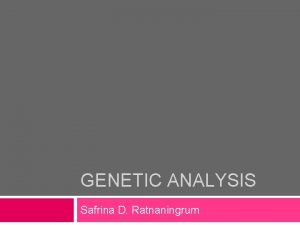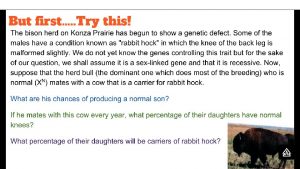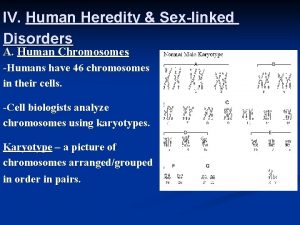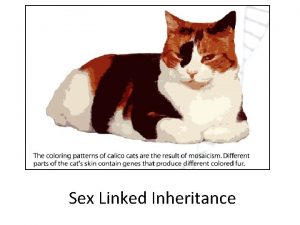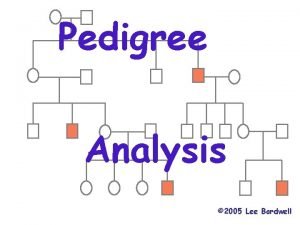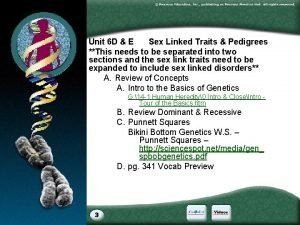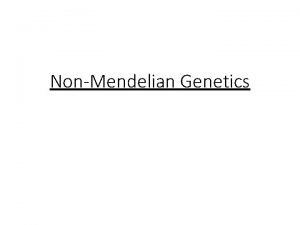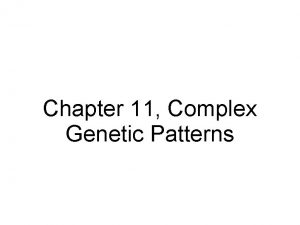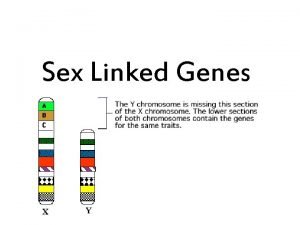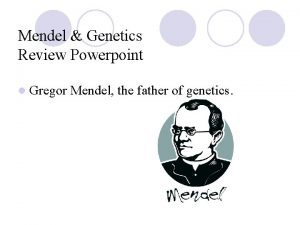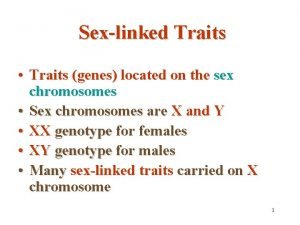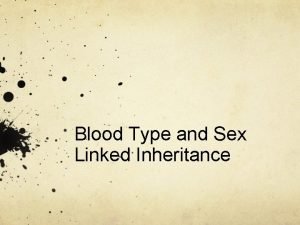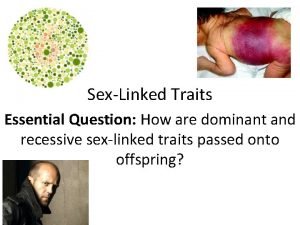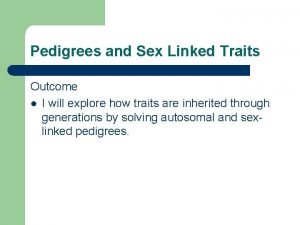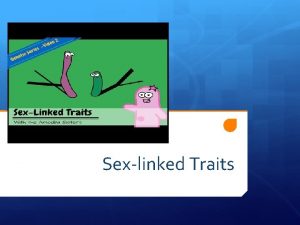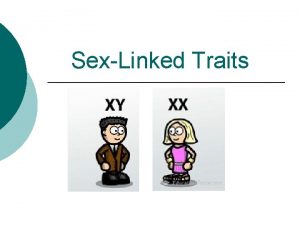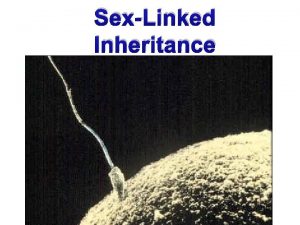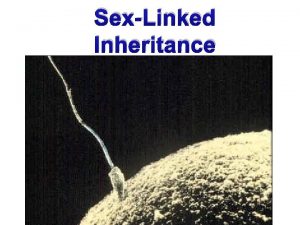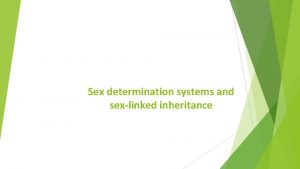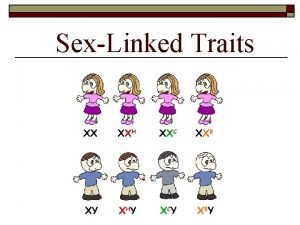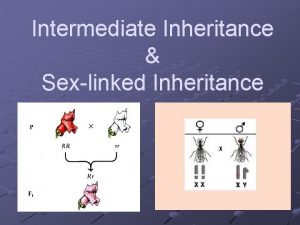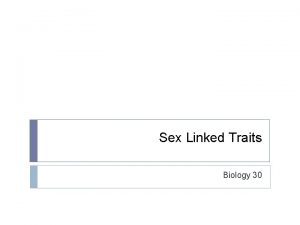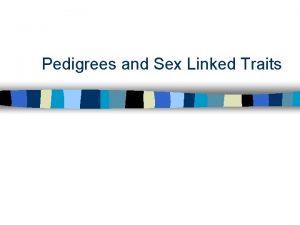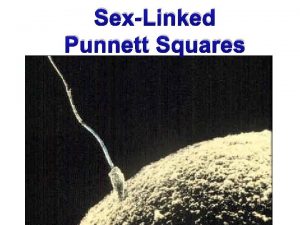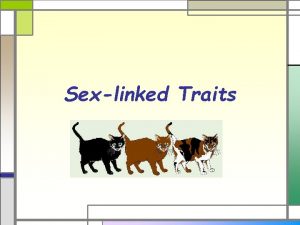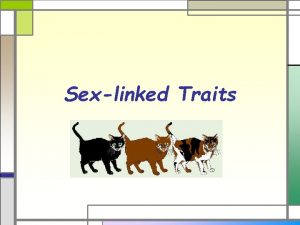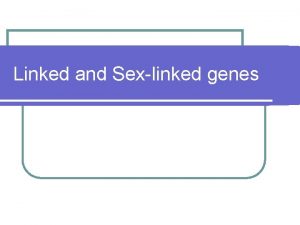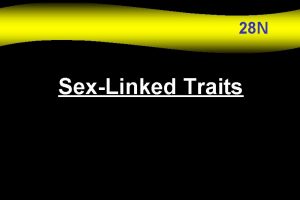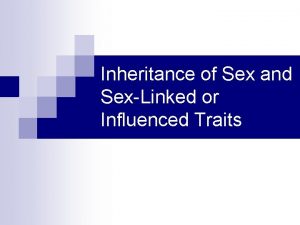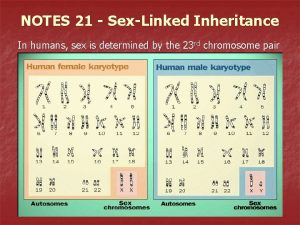Sex Linked Dominant Inheritance Sexlinked dominant inheritance is



































- Slides: 35

Sex Linked Dominant Inheritance ‣ Sex-linked dominant inheritance is rarer because all daughters of affected males will be affected (the heterozygous condition is not a carrier). Unaffected female ‣ Sex-linked dominant traits are never passed from father to son. ‣ Affected females produce 50% normal and 50% affected offspring Some X-linked dominant conditions, such as Aicardi syndrome, are lethal to boys. They are usually seen only in girls but may be seen in males with Klinefelter syndrome (XXY) Affected male

Autosomal & Sex-Linked Genes ‣ Genes on one or other of the sex chromosomes produce inheritance patterns different from that shown by autosomes: Autosomal Genes Sex-Linked Genes 1. All individuals carry two alleles of each gene 1. Males carry only one allele of each gene (hemizygous) 2. Dominance operates in both males and females 2. Dominance operates in females only. 3. Reciprocal crosses produce the same results 3. Reciprocal crosses produce different results. 4. Alleles passed equally to male and female offspring 4. ‘Criss-cross’ inheritance pattern: father to daughter to grandson, etc Reciprocal Cross A reciprocal cross involves a pair of crosses in which the phenotypes of the partners are reversed: Reciprocal cross X Colorblind female Normal male X Normal female Colorblind male Different results from the two crosses indicate that sex-linkage of the gene is controlling the trait

Linked Genes ‣ Genes on the same chromosome are said to be linked. They are inherited together as a unit and do not undergo independent assortment. One homologous pair of chromosomes Oocyte ‣ Linkage can alter expected genotype and phenotype ratios in the offspring. In this example, only two types of gamete are produced instead of the expected four kinds if the genes were assorted independently. Gametes Meiosis Ab Ab a. B Genes A and B control different traits and are on the same chromosome a. B

Sex Linkage ‣ Sex linkage refers to the phenotypic expression of an allele that is dependent on the sex of the individual and is directly tied to the sex chromosomes. ‣ Most sex linked genes are present on X Y the X chromosome (X-linkage) and have no corresponding allele on the smaller male chromosome. ‣ In some cases, a phenotypic trait is determined by an allele on the Y chromosome. Because the Y chromosome is small and does not contain many genes, few traits are Ylinked and Y-linked diseases are rare. Note the size differences between the X and Y chromosomes. The Y lacks alleles for many of the genes present on the X.

Sex Linkage Unaffecte d father ‣ Sex-linked traits show a Carrier mother distinct pattern of inheritance. Fathers pass sex-linked alleles to all their daughters but not to their sons. X Mothers can pass sex-linked alleles to both sons and daughters. In females, sex-linked recessive traits will be expressed only in the homozygous condition. In contrast, any male receiving the recessive allele from his mother will express the trait. Y XY Unaffected son X XX Unaffected daughter X XY XX Carrier daughter Affected son

Sex Linked Recessive Inheritance ‣ For a recessive trait controlled by a gene on the X chromosome, the features of inheritance can be illustrated with the standard symbols used on pedigree charts. Note that: Unaffected female Affected male Carrier More males than females express the trait. Carrier females do not show the trait but pass it to sons. All daughters of affected males will at least be carriers of the trait. Famously, Queen Victoria was a carrier of the allele for hemophilia, passing it to one of her sons and, through her daughters, to the royal families of Prussia, Russia, and Spain.

Sex Linkage in Humans ‣ A rare form of rickets in humans is a sex-linked dominant trait. It is determined by a dominant allele of a gene on the X chromosome. This condition is not treatable with vitamin D therapy. ‣ A typical inheritance pattern is shown. XR indicates affected by rickets.

Sex Linkage in Cats 1 ‣ The orange color of cats (red) is caused by the O gene, which changes black pigment into a reddish pigment. ‣ The O gene is carried on the X chromosome. The recessive allele, o, codes for non-red (black). ‣ A tortoiseshell phenotype occurs when both alleles occur together. This can only occur in female cats because two X-chromosomes have to be present to carry the black and orange alleles. Genotypes and phenotypes ‣ Allele Types: Xo = Black pigment XO = Orange pigment XO XO , XO Y Orange coated female, male Xo. Xo, Xo. Y Black coated female, male XO Xo Tortoiseshell coat (intermingled black and orange in fur) in female cats only

Inherited Traits in Cats Polydactyly ‣ Coat colors and other inherited features are interesting because they exhibit common genetic phenomena: Dominance The polydactylism gene with the dominant allele (Pd) produces paws with extra digits. Recessiveness Dilution The dilution gene with the recessive allele (d) dilutes black to grey, and orange to cream. Complementary Genes The dominant agouti gene (A) must be present for the tabby gene (T) to be expressed. Tabby expression

Inherited Traits in Cats ‣ Coat color genes: Multiple alleles The albino series (C) produces a range of phenotypes from full color intensity to true albino. Incomplete dominance The spotting gene (S) has three phenotypes ranging from extensive spotting to no spotting at all. Grey spotting Lethal alleles The manx gene, (ML) produces a stubby or no tail (lower right) in the heterozygote, while the homozygote (ML ML) condition is lethal, and (MM) is normal. Manx

Inherited Traits in Cats ‣ Coat color genes: Pleiotropy – single gene has multiple effects The white gene (W) removes pigment from the coat and can cause congenital deafness. Sex linkage The orange coat color gene is Xlinked and can convert black pigment to orange. Since female cats have two X chromosomes they have three possible phenotypes: black, orange and tortoiseshell. Males can normally only exhibit two phenotypes: (black and orange). White cats usually have blue or orange eyes. Those with blue eyes are often deaf. Odd eyed cats (one blue, one orange) are deaf on the blue-eyed side.

Inherited Traits in Cats Random gene inactivation Patchwork coloring in tortoiseshell cats is caused by the random switching off of one or other of the X chromosomes in the female during embryonic development. The colors are expressed in patches. Environmental effects The dark color pointing in siamese and burmese cats where the gene (cs) is only active in the cooler extremities such as the paws, tail and face.

Coat Color Variation in Cats Blotched tabby (tb) Broad irregular bands in whorls. Lacks stripes Wild type (A_B_T_) Mackerel (striped) tabby with even, well defined, black vertical stripes. The background color is agouti. Marmalade (XOXO) The orange color is expressed, along with the tabby pattern. Non-Agouti (aa. B_D_) The absence of the dominant agouti allele with no pigment dilution produces a jet black cat Calico Similar to tortoiseshell but with white fur as well as black and orange Sex-linked orange (XOXO) Orange coat with little or no tabby pattern Tortoiseshell (XOXo) Sex linked and only in females. Coat is a mixture of orange and black

Inherited Traits in Cats The American Curl is the result of a spontaneous mutation that was first reported in 1981.

Sex Linkage in Cats 2 ‣ For the parent cats depicted here, the following can be determined from their mating: Tortoiseshell female Parent cats X ? Parental genotypes Possible gametes Genotypes and phenotypes of their possible offspring (including their sex). Gametes Possible fertilizations Allele types: X 0 = Orange pigment X● = Black pigment Kittens 2 Orange female Tortoiseshell female Black male 2 Orange males

Sex Linkage in Cats 2 ‣ For the parent cats depicted here, the following can be determined from their mating: Tortoiseshell female Parent cats Orange male X XOXo XOY Parental genotypes Possible gametes Genotypes and phenotypes of their possible offspring (including their sex). XO Xo Gametes XO Y Possible fertilizations Kittens XOXO XOY Xo XO Xo Y Orange female Orange male Tortoiseshell female Black male

Sex Linkage in Cats ‣ EXERCISE: Blackfemale By knowing the coat color of parent cats the coat colors of the offspring can be determined. For the parent cats depicted here, determine: X Xo Xo Xo Genotypes and phenotypes of their possible offspring XOY Xo XO Gametes Y Possible fertilizations Their genotypes Possible gametes Orange male Parent cats Xo XO Kittens Xo Y Male kittens Xo XO Xo Y Female kittens Genotypes Phenotypes X o. Y Black X o. X O Tortoiseshell

Multiple Alleles in Blood ‣ The four common blood groups of the human ABO blood group system are determined by three alleles: A, B, and O (also represented in some texts as IA, IB, IO or just i). This is an example of a multiple allele system for a gene. ‣ ABO antigens consist of sugars attached to the red blood cell surface. These sugars provide the individual antigenic properties. The alleles code for enzymes that join these sugars together. Allele O produces a non-functional enzyme that is unable to make changes to the basic antigen (sugar) molecule. The other two alleles (A, B) each produce a different enzyme that adds a different, specific sugar to the basic antigen. ‣ Any one individual possesses only two alleles and they are expressed equally. RBC

Multiple Alleles in Blood Phenotype (blood group) O Genotypes Allele codes for molecule OO Precursor A B AB Precursor antigen without extra sugar at end AA, AO acetylgalactosamine added to precursor BB, BO galactose added to precursor AB Contains both sugars Antigen Antibodies in serum None (also called universal donor) None (also called universal recipient)

Multiple Alleles in Blood ‣ Blood donors must be compatible otherwise the red blood cells of the donated blood will clump together (agglutinate) and block capillaries. Phenotype Genotypes Antibodies in serum Results from adding RBCs from groups below to serum from groups at left A A AA, AO anti-B B BB, BO anti-A AB AB none O OO anti-A anti-B B AB O

Multiple Alleles in Blood ‣ EXAMPLE 1: For both parents with AB Blood blood type, half of the group: AB offspring will be the same as the parents (AB), one quarter will be type A Parent genotypes and one quarter will be type B. Gametes A Blood group: AB X AB AB B A B Possible fertilizations Children's genotypes Blood groups AA AB AB BB A AB AB B

Multiple Alleles in Blood ‣ EXAMPLE 2: Two parents with blood groups A and B may produce offspring with all four possible blood groups: AB, A, B and O. ‣ This may only occur if both parents are carrying the allele for group O. Blood group: B Blood group: A X Parent genotypes Gametes AO BO B O A O Possible fertilizations Children's' genotypes Blood groups AB AB BO AO OO B A O

Genetic Counseling ‣ Genetic counseling is an analysis of the risk of producing offspring with known gene defects within a family. ‣ People usually consider genetic counseling if they have a family history of a genetic disorder, or if a routine prenatal screening test yields an unexpected result. ‣ Counsellors: Identify families at risk and investigate the problem present in the family. Interpret information about the disorder. Analyze inheritance patterns and risks of recurrence. Review available options with the family. ?

Genetic Counseling Genetic counseling provides information to families who have members with birth defects or genetic disorders, and to families who may be at risk for a variety of inherited conditions. About half of the cases of childhood deafness are the result of an autosomal recessive disorder. Early identification of the problem allows early appropriate treatment. Pregnant women often have a prenatal test for chromosomal abnormalities such as Down syndrome (trisomy 21) and abnormalities of development such as neural defects.

Autosomal Dominant Disorders ‣ These are inherited disorders caused by dominant alleles on autosomes. Dominant conditions are evident both in heterozygotes and in homozygous dominant individuals. Examples include: Diabetes insipidus: Inadequate output of anti-diuretic hormone (ADH), leading to the production of large amounts of urine and extreme thirst. Also produced by an X-linked gene. Huntington disease: Involuntary movements of the face and limbs with later general mental deterioration. The beginning of symptoms is highly variable, but occurs usually between 30 to 40 years of age. MRI scans of the brain (top) and blood tests (below) can be used to diagnose Huntington disease.

Autosomal Recessive Disorders ‣ Inherited disorders caused by recessive alleles on autosomes. Recessive conditions are evident only in homozygous recessive genotypes. (Photo: UK Cystic Fibrosis Gene Therapy Consortium) Cystic fibrosis: Dysfunction of chloride transport in glands; thick mucus leads to pneumonia and emphysema. Death usually occurs in childhood. CF is the most common lethal genetic disorder in childhood. Maple syrup urine disease: Mental and physical retardation produced by a block in amino acid metabolism. Isoleucine in the urine produces the characteristic odor. Tay-Sachs disease: A lipid storage disease causing progressive paralysis, mental deterioration, and blindness. Death usually occurs by three years of age. The symptoms of cystic fibrosis are treated with inhaled drugs and physical therapy to clear the lungs of mucus. CF has an incidence of about 1 case 3700 live births.

Maternal imprint on chromosome in egg Genomic Imprinting ‣ The phenotypic effects of some mammalian genes depend on whether they were inherited from the mother or the father. Just as cells inherit genes, they also inherit instructions that tell the genes when to become active, in which tissue, and to what extent. Paternal imprint on chromosome in sperm Inherited imprinting affects the development of the individual Somatic cells Maternal and paternal chromosomes are differently imprinted. Each generation, chromosomes are newly imprinted.

Imprinted Genes ‣ How are imprinted genes different? In some cases, an imprinted gene is activated only if it is inherited from the father; in other cases, only if it comes from the mother. The corresponding allele is inactivated. Paternal chromosome Maternal chromosome Deletion mutation Evidence of this is seen in two human genetic disorders. Both are caused by the same mutation: a specific deletion of chromosome 15. If the mutation is inherited from the father, the result is Prader-Willi syndrome. If the mutation is inherited from the mother, the result is Angelman syndrome. Prader-Willi syndrome Angelman syndrome Mental retardation, obesity, short stature, unusually small hands and feet Uncontrollable laughter, jerky movements, motor and mental abnormalities

Gene Silencing ‣ How are genes imprinted? Imprints may act as silencers or activators for imprinted genes. DNA methylation is a well understood example of an imprinting phenomenon. DNA methylation turns off gene expression by establishing a silent chromatin state through the addition of a methyl-group to cytosines in the DNA. This changes the state of the chromatin so that the expression of any genes in the methylated region is inhibited. In this way, either a maternal or paternal gene may be silenced. Methylation is also important in the Xinactivation of chromosomes. Which genes did you inherit from your mother and which from your father? For some genes, imprinting will affect phenotypic expression.

Identifying Defective Genes ‣ Increasingly, there are DNA tests for the identification of specific defective genes. ‣ While screening for many genetic disorders is now recommended, the use of pre-symptomatic tests for adult-onset disorders, such as Alzheimer's, is still controversial. ‣ Genetic testing may involve: Test Explanation Carrier screening Identifying unaffected individuals who carry one copy of a gene for a disease that requires two copies for expression of the disease. Preimplantation genetic diagnosis Screens for genetic flaws in embryos used in in vitro fertilization. Prenatal diagnosis Tests for chromosomal abnormalities such as Down syndrome. Presymptomatic testing Testing before symptoms appear to determine the risk of developing adult-onset disorders, e. g. Huntington’s disease or cancer. Biochemical tests for gene products such as enzymes and other proteins. Microscopic examination of stained or fluorescent chromosomes. Examination of the DNA itself.

Sex Determination ‣ In most cases, the determination of the sex of an organism is controlled by the sex chromosomes provided by each parent. ‣ These have evolved to regulate the ratios of males and females produced and preserve the genetic differences between the sexes. Y In humans and other mammals, males are the heterogametic sex because each somatic cell has one X and one Y chromosome (i. e. the two sex chromosomes are different). Males are not always the heterogametic sex. In birds and butterflies, the female is the heterogametic sex, and in some insects the male is simply X whereas the female is XX. X

XY Sex Determination ‣ In the XY type, sex determination is based on the presence or absence of the Y chromosome; without it, an individual will develop into a female. ‣ XY sex determination occurs in: Female Mammals (including humans) Fruit fly Drosophila Some dioecious (separate male and female) plants such as kiwifruit. ‣ ‣ Females are homogametic with two similar sex chromosomes (XX). The male has two unlike chromosomes (XY) and is heterogametic. Primary sex characteristics are initiated by genes on the X. ‘Maleness’ is determined by the Y. Gametes X XX Parents X X XY X Y Possible fertilizations Offspring XX XY XX Sex: Female Male Female XY Male

WZ Sex Determination ‣ In the WZ type, the female determines the sex of the offspring. Female Male ‣ The male is the homogametic sex (ZZ), while the female has two unlike chromosomes (ZW). ‣ WZ sex determination occurs in: ZW Parents ZZ X Birds Butterflies and moths Some fish Gametes Z W Z Z Possible fertilizations Offspring Sex: ZZ Female ZZ ZW ZW Male Female

XO Sex Determination ‣ In some insect orders, the female has two similar sex chromosomes (XX) while the male only has one (XO). ‣ In the sperm produced by males, there is a 50% chance that it will have a sex chromosome and create a female offspring when it fertilizes an egg. ‣ XO sex determination occurs in: Grasshoppers Aphids Honey bees Hemiptera (bugs) Female XX Parents Gametes Male X X X Possible fertilizations Offspring Sex: XX Female X XX Male Female X Male

Sex Determination in Honey Bees ‣ In honey bees sex is determined by the number of sex chromosomes, but environment in the hive has an influence too. ‣ Males or drones Result from unfertilized eggs and have one sex chromosome (monoploid). Queen Drone XX ‣ Females have two sex chromosomes but diet determines if they are reproductively active. Queens are supplied with a diet of royal jelly. Sterile workers are not given royal jelly. X Egg not fertilized X Not given royal jelly X X Egg fertilized X XX Given royal jelly X XX XX Drone (Fertile male) Worker (Sterile female) Queen (Fertile female)
 X linked punnett square
X linked punnett square Sex sex sex
Sex sex sex Kurt bumby
Kurt bumby Secondary sexual characters
Secondary sexual characters Greenhouse sex
Greenhouse sex Sex sex sex
Sex sex sex X linked punnett square
X linked punnett square Outsider rules pedigree
Outsider rules pedigree Sex linked dominant pedigree
Sex linked dominant pedigree Sexlinked inheritance
Sexlinked inheritance Difference between an array and a linked list
Difference between an array and a linked list List adalah
List adalah Advantage of linked list
Advantage of linked list Mosaicism
Mosaicism Y linked inheritance
Y linked inheritance Whats sex linked
Whats sex linked What is a sex linked disorder
What is a sex linked disorder Whats sex linked
Whats sex linked Sexlinked vs autosomal
Sexlinked vs autosomal Sex linked pedigree
Sex linked pedigree Multiple alleles
Multiple alleles Dominant vs recessive genetic disorders
Dominant vs recessive genetic disorders X linked traits
X linked traits Autosomal vs sex linked
Autosomal vs sex linked Sex linked trait
Sex linked trait Is blood type sex linked
Is blood type sex linked Carrier female genotype
Carrier female genotype Punnett square blood type ab and o
Punnett square blood type ab and o Flurorescein
Flurorescein Sexlinked traits
Sexlinked traits Color blindness is a sex-linked, trait.
Color blindness is a sex-linked, trait. Hemophilia punnett square worksheet
Hemophilia punnett square worksheet Sex cat
Sex cat Advanced higher biology unit 2
Advanced higher biology unit 2 Sex determination and sex linkage
Sex determination and sex linkage Once a sex offender always a sex offender
Once a sex offender always a sex offender













